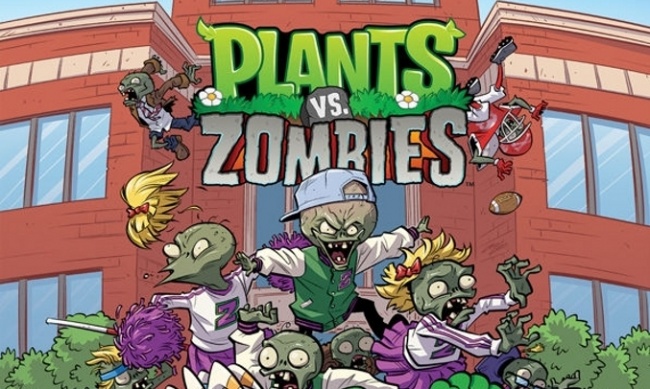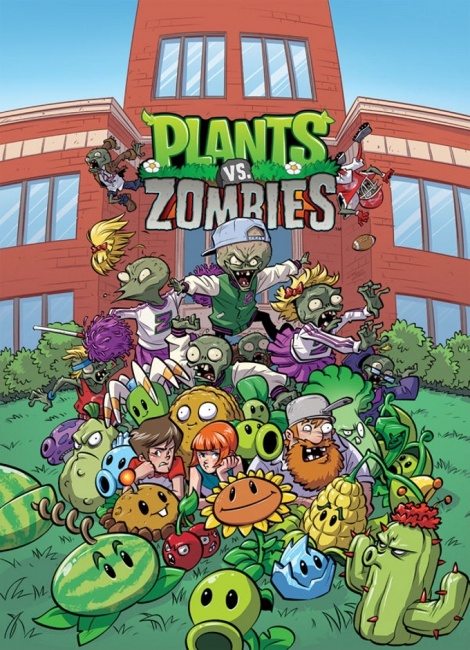We caught up with Plants vs. Zombies and Bandette writer Paul Tobin, to talk about these two very different comics that really are for all ages. Plants vs. Zombies is Dark Horse’s best selling property for kids, with over 1.2 million copies in print in all markets (see “Dark Horse CEO Mike Richardson on Kids Titles”) behind two hardcover collections of stories by Tobin and artist with a third on the way; while Bandette, by Tobin and artist Colleen Coover, has garnered numerous Eisner Award nominations (see “The 2015 Eisner Award Nominees”), behind two collections of the comics that appear first in digital via Monkeybrain.
Let’s talk first about Plants vs. Zombies. What is the target audience of the games, and what is the target audience for the comics?All ages for both, really, perhaps skewing a little younger for the classic games. That said, PopCap, Dark Horse and I have collectively strived for “all ages” to mean just that. Too many “all ages” labels seem contrived to mean “ages 6-12,” where I’ve always believed that it’s possible to create games / comics / movies and all creative efforts so that there truly is something for every age level. That philosophy has fueled a significant portion of my career working on.
In general, how do you approach creating the storylines for Plants vs. Zombies comics relative to the content in the game?
When I was first brought in, all that existed was the original game, meaning nothing more than plants lining up against zombies and marching forward in battle, in straight lines. It was an interesting challenge to expand that into a full story. PopCap let me cut loose, though, so I established the greater town of Neighborville, and two new characters, Patrice (Crazy Dave’s niece, and the only one who can understand him when he talks) and Nate. This allowed me to have characters with a range of speech past, “Brainzzz?” Beyond that, I just want a wacky thrill ride, but a cohesive one; things have to make sense within the world we’re created. And then I just start going a little crazy. If I feel like something’s too crazy, I try to figure out a way to make it work. If I can’t figure out a way to work, I make it crazier and then check again.
How does the comics timeline connect with events in the game, if at all?
We’re working on a loose timeline for when things are happening, how time progresses in both the game and the comic. There’s some upcoming story material that’s going to explain game aspects that haven’t seen the light of day, yet. Beyond that, the comics have introduced future versions of Patrice and Nate, humorously gritty versions, because there IS a time in the future when Zomboss achieves at least a part of his dream. Luckily, time travel has been introduced in the game, so we can play with that, whether striving to change the future, or going back in time to battle dinosaurs, or the dread pirate Chestbeard.
How do the storylines in the first two volumes connect with the game, with each other, and now, with the third story?
They all read separate as story arcs, so starting with any volume is fine. We do have a loose continuity, such as Lawnmageddon (Vol. 1) being where Patrice and Nate first meet… and then have to stave off a major zombie invasion in Neighborville, when Zomboss invents a cloud that blocks sunlight, depriving the plants of much of their power. And then in Timepocalypse (Vol. 2), Zomboss invents a machine that can vacuum up sunlight, but… it explodes. In fact, it explodes so hard that the pieces are flung throughout time, forcing everyone to race through history to retrieve them. Our third volume (Bully for You) will delve into Zomboss’s college life, and how he was a major jerk, and how Nate and Patrice get caught between two warring zombies factions in today’s world, where Zomboss faces some zombie vs. zombie payback. Overall, we’re establishing a timeline, but we do want to keep the books as individual volumes.
We know these have been big sellers for Dark Horse—anything you can tell us about fan response beyond the numbers?
It’s been incredible! It’s the book where I get the most actual fanmail, and not just emails but real letters! They still exist in this world! Hand-written and everything! They’re always charming, too, with TONS of questions about the zombies (mostly) and the plants, and When Will There Be MORE?!?!?
Anything else retailers should know about selling Plants vs. Zombies?
Just that I do think the book is all ages, so if anyone is looking for a fun romp, it’s not a bad place to go. And we’re working some of the comic elements into the games these days, so sometimes the comics are going to debut certain game elements and characters, and that’s always fun.
Now let’s talk about Bandette. What is the target audience?Definitely everyone, for Bandette. We strive to make it all-ages, but it’s the level of all-ages when I was personally growing up, when you could get away with a lot more. We want to get away with as much as we can in Bandette, because artist Colleen Coover and I just want to relentlessly have fun. In one way, the target audience for Bandette is… me and Colleen. All throughout my life, all my favorite comics, movies, books and music and so on… they’ve always clearly been created by people who LOVE what they’re doing, so as long as we love creating Bandette (and we do) then I think we’ll be fine.
How big is the Monkeybrain and comiXology audience for the digital versions?
Honestly, I’m not sure. I’ve never been someone who looks at sales figures and that sort of thing. I think that for a creator that can end up being a stumbling block. If sales are good then you try to keep the ship steady, and if they’re bad you’re going to try to change things. You can go wrong both ways: sometimes it’s just best to keep your head down and create the best work you can, and sometimes that’s the way it all works out. Both Monkeybrain and ComiXology seem very happy with us, I know that!
How did the audience for Bandette change when you first released a print volume?
It expanded, for sure. I’m not sure there was any particular audience that was brought in, though, other than “People Who Don’t Like Digital.” It was also gratifying to see how many people (a lot) had already been reading online, but wanted the collection as well. Of course, we added a bunch of new material, too, as a reward.
What’s different about the second volume (just released)?
It has a lot of what we did thematically in the first volume, with the guest artist “Urchin” short stories, and a whole range of interesting behind-the-scenes looks, including scripts, a rundown of the real items Bandette steals, and so on. I think one thing that’s really interesting is the prose story. As a novelist, I enjoy adding prose stories, but while the first volume had a look at how Bandette and Daniel first met, the prose story in the 2nd volume is from Margot’s viewpoint, and we use it to not only for some greater reveals of what has gone before, but we set up the next big arc, The House of The Green Mask, and a glimpse at the next major villain.
What should retailers know about selling Bandette?
Well… it’s probably going to pick up again, what with another round of Eisner nominations, combined with it being one of the stories in Dark Horse’s FCBD giveaway, which should focus attention. Really… the prime thing about Bandette is that if you have a customer that likes charming comics, or adventure comics… here’s your answer.





